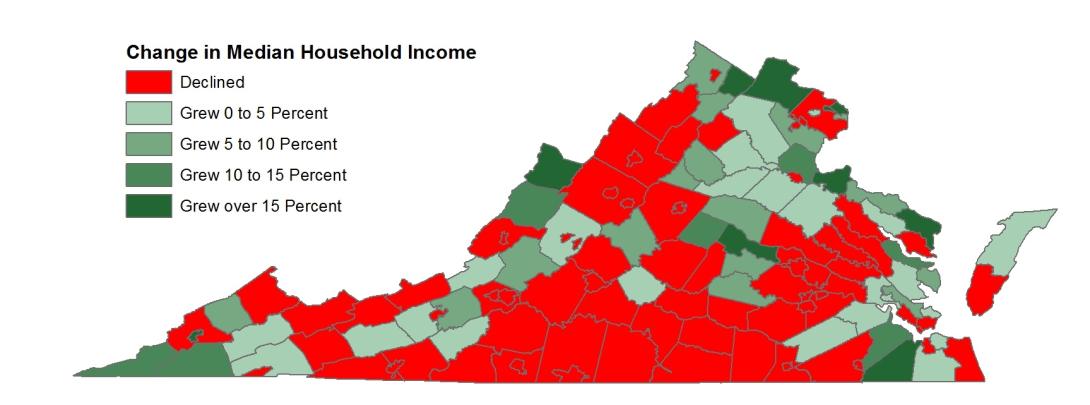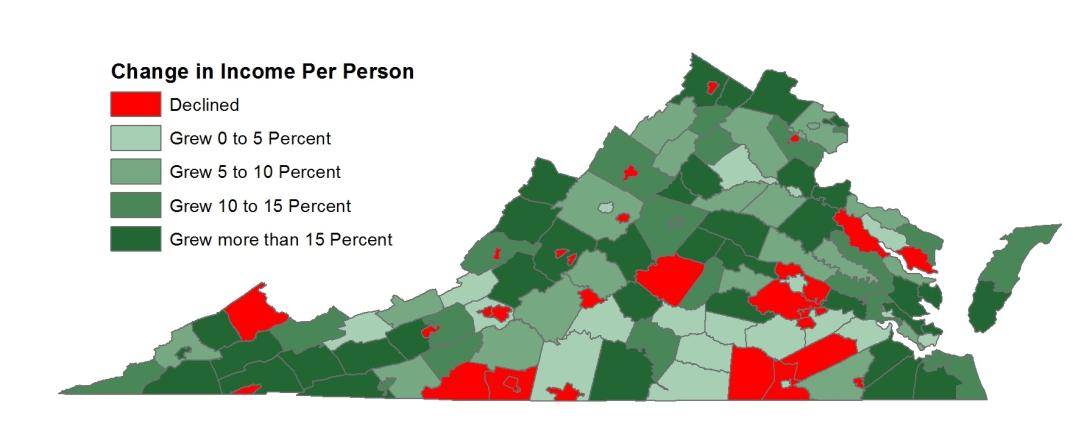Rural gentrification: Incomes are rising in some surprising places
The financial crisis and its aftereffects had a significant impact on American’s incomes. But the slow income growth that continued after the recession ended has also increased public awareness that income stagnation is a national problem that pre-dates the financial crisis and extends back into the late 1970s. Between 1950 and 1975, the U.S. median household income rose by over 50 percent. Since then income growth has been nearly flat. In Virginia, which had a comparatively healthy economy over the past few decades, the median household income rose less than 2 percent over the entire period between 1990 and 2013. But on the local level in Virginia, changes in income have been considerably more varied since 1990.

Large swaths of Southside, the Valley, and the Richmond metro area have experienced declines in their median household incomes during the period between 1990 and 2013. Martinsville’s median household income was halved during the past two decades and by 2013 the city had the lowest median household income in the state. Many of the localities whose residents’ incomes rose during this period were in the outer suburbs of Virginia’s Urban Crescent, which stretches from Northern Virginia to Hampton Roads, and grew wealthier as more workers moved out to them during the housing boom.

Curiously, most of the other localities where residents’ incomes grew between 1990 and 2013 were in rural areas far from job centers, such as Highland County in the Allegheny Mountains and Northumberland County on the Northern Neck. What these counties have in common– besides being deeply rural– is that they have attracted a disproportionate amount of retirees with relatively higher incomes. The in-migration of retirees has caused many rural counties to both age faster and grow wealthier than other parts of Virginia. Highland County’s median age rose by 15 years from 1990 to 2014, while in contrast, Fairfax County’s median age rose by 4 years.

Comparing income levels between Virginia’s rural and urban areas can be difficult because of their very different age structures. Highland County’s large older population means that its typical household size is half that of Fairfax County’s, since seniors are less likely to have children in the house and more likely to live alone. Undoubtedly, Fairfax County has higher income levels than Highland. When you compare their median household incomes, Fairfax is 120 percent richer than Highland. But when you compare the average income per person, Fairfax is only 90 percent richer than Highland, since more of Highland’s residents earn an income or pension and fewer have children.
The aging population in most of Virginia’s counties since 1990 and shrinking household size is one of the reasons why the average income per person has risen more often across the Commonwealth than the median household income. But in some counties such as Fairfax, average incomes have also risen from growth in their upper income populations (see the first chart); a few Donald Trumps can easily push up a county’s average income while having little effect on its median household income.

When comparing the maps of the change in median household income and average income per person, there are some noticeably similar trends. Some suburban counties on the edges of metro areas also saw their average income per person increase. But three quarters of the counties with the largest gains in their average income per person were rural, most of which have also aged faster than the rest of the state during the period between 1990 and 2013.
It is notable that average income per person rose more in rural areas, particularly parts of Southwest Virginia, than it did in much of Virginia’s Urban Crescent. However, though most of Northern Virginia remains considerably wealthier, income trends since 1990 do not support the idea that urban areas are pulling away from rural areas economically. Rural counties are not only often growing wealthier from higher income retirees moving in but also because more generous federal policies have caused income levels for most of their senior population to rise in recent decades.
Despite the larger gains in income of the residents in rural counties, there are some reasons to be careful when interpreting the data. The Census income data is capturing counties at a point in time when they are still recovering from the recession. Because counties near major job centers are often more affected by the economy, many suburban counties suffered more during the recession. But as the economy accelerates, their income growth may soon outpace rural areas again. Yet as the chart at the beginning of the post shows, income stagnation has been widespread for decades, though perhaps not in all of Virginia’s rural counties.


